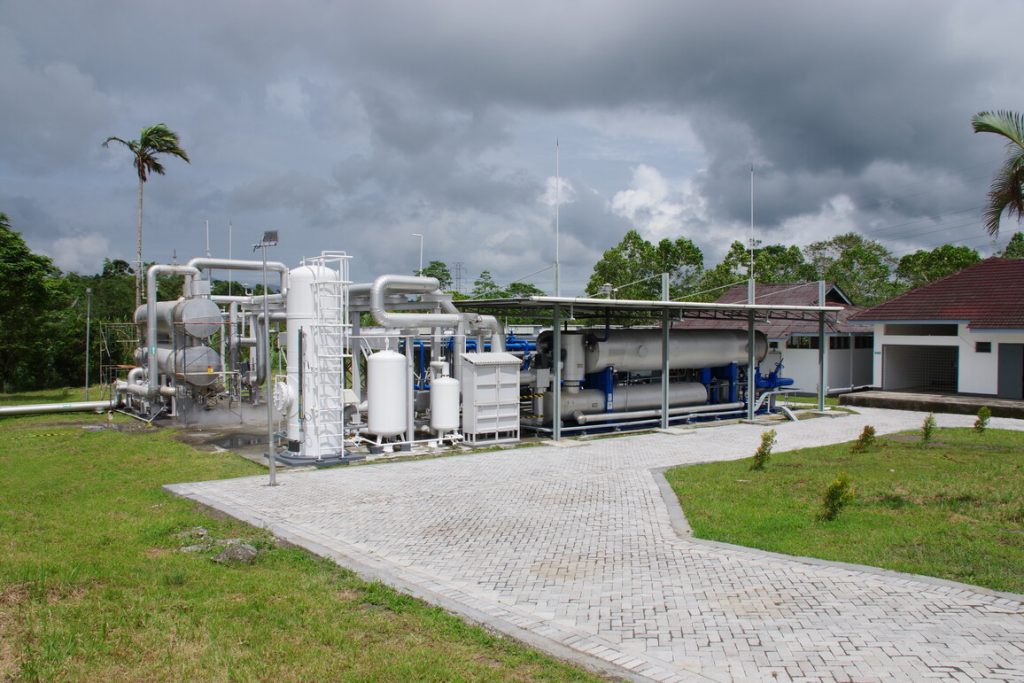 Low-temperature pilot plant by Duerr, a GFZ pilot project at Lahendong, Indonesia (source: Stefan Kranz, GFZ)
Low-temperature pilot plant by Duerr, a GFZ pilot project at Lahendong, Indonesia (source: Stefan Kranz, GFZ)
 Alexander Richter7 Feb 2021
Alexander Richter7 Feb 2021Geothermal energy is an almost inexhaustible and environmentally friendly source of energy. How geothermal energy can be used to generate electricity is explained by Dr. Ali Saadat, scientist at the German Research Center for Geosciences, in an interview with bmbf.de, the platform of the German Federal Ministry of Eduction & Research. The Helmholtz Center Potsdam, … Continue reading German led low(er) temperature geothermal demonstration project in Indonesia
Geothermal energy is an almost inexhaustible and environmentally friendly source of energy. How geothermal energy can be used to generate electricity is explained by Dr. Ali Saadat, scientist at the German Research Center for Geosciences, in an interview with bmbf.de, the platform of the German Federal Ministry of Eduction & Research.
The Helmholtz Center Potsdam, German Research Center for Geosciences, has built a low-temperature demonstration power plant on Sulawesi in Indonesia and handed it over to a regional operator. What are the reasons for this commitment?
Indonesia has around 40 percent of the world’s designated geothermal resources. So far, however, only so-called high enthalpy fields have been used there, in which hot steam is conveyed. This represents the conventional geothermal use. However, if geothermal energy with lower temperatures is tapped, the geothermal potential can be significantly expanded. As part of our GeNie project , we built a demonstration power plant with a binary circuit in Indonesia and advanced the conception of such a power plant prototype there. That was an exciting job.
How do these power plants work?
They work like conventional steam power plants. In our case, we are talking about a Rankine cycle with organic resources (Organic Rankine Cycle, ORC). The pressure and temperature here are far below the values ??found in classic steam power plants. The heat from the thermal water is transferred to the ORC circuit via a heat exchanger, which contains a fluid with a low boiling point. This fluid vaporizes and drives the turbine.
The general public usually associates the term geothermal energy with the extraction of geothermal energy to heat buildings. Under what conditions is it worth converting the thermal energy stored in the earth into electricity?
You are probably referring to the local public, because the use of heat is mainly an issue in Germany and Northern Europe. A certain minimum temperature level of the geofluid, which also flows with a sufficient mass flow, is decisive for geothermal electricity generation. Electricity generation makes sense if the direct use of heat is either not possible because the users live too far away from the conveyor system or the demand is significantly lower than the usable geothermal heat.
Could the technology of low-temperature power plants be used worldwide, provided the appropriate geothermal resources are available?
This technology is already used worldwide in geothermal energy, there are hundreds of ORC systems worldwide on five continents. The use of ORC technology is also possible in other areas. Examples are coupling to biogas plants, the use of waste heat from industrial processes or waste heat from combined heat and power plants.
Where are the most important heat reserves in Germany and Europe?
From my point of view, the importance of a heat reservoir results from the temperature of the stored thermal fluid. So-called near-surface geothermal energy for the use of low-temperature heat for heating purposes is available almost everywhere in Germany and Europe. District heating, on the other hand, requires a higher temperature level. If electricity is to be produced, the temperatures have to be even higher. The use of the heat reservoir depends on the desired application such as heat or electricity as well as the economic and legal framework. There are three priority areas in Germany for higher temperatures and the use of deep geothermal energy: the North German Basin, the Molasse Basin on the northern edge of the Alps and the Upper Rhine Rift.
Deep geothermal energy is also viewed critically due to the risk of earthquakes. What are the causes and how can these “side effects” be avoided?
The operation of geothermal systems alone does not cause high magnitude earthquakes. However, seismicity can be triggered. In places that are tectonically under tension, geothermal water can penetrate the movement path of the rock blocks involved, reduce friction and trigger an earthquake. Such events bring geothermal energy into disrepute, but they could be avoided through more precise knowledge of the subsurface and operational management adapted to it. In cases of natural seismicity that exists independently of geothermal use, as in the project in Lahendong, a real-time monitoring system can increase the longevity, reliability and operational safety of the plant.
Which areas of application for geothermal energy are conceivable besides the heat supply of buildings, the heating of greenhouses and the generation of electricity?
Those are three very large areas of application. I see other uses, for example, in the generation of cold when I think of the warmer summers in Europe. In addition, geothermal energy can make a contribution to efficient energy use through intelligent storage of heat and cold, for example through aquifer storage. On the other hand, the material use of the hydrothermal deep waters for the extraction of raw materials comes into focus, for example for the extraction of lithium or copper.
Which technical challenges still have to be solved before widespread use in Europe?
It is not just technical challenges that influence developments in Europe. Certainly, economic risks must also be minimized, which can be achieved with new and better exploration methods. Other important topics are the sustainable management of the reservoirs and the use of powerful pumps and materials, so that the operational safety and reliability of the systems is increased. A main focus should also be placed on improving the economic and, above all, the legal framework in order to shorten the development times of geothermal projects.
If we look to the future: can geothermal energy become the most important renewable energy source?
Geothermal energy is already one of the most important renewable energy sources worldwide because it is available all year round as a non-fluctuating energy source and can be used as required. Geothermal energy can therefore make an important contribution to the supply of electricity and heat in Germany and Europe and thus contribute to decarbonisation and climate protection. In Germany, the use of heat will continue to be in the foreground in the future, while in other countries such as Turkey or Indonesia it will be more electricity generation.
The GeNie Project (note: the German word of “Genie” can be translated to “genius” in English)
As part of the GeNie project funded by the Federal Ministry of Education and Research ( BMBF ), a geothermal demonstration power plant was built and tested at the geothermal site in Lahendong on Sulawesi together with Indonesian partners. The aim of the project was to demonstrate reliable and efficient geothermal low-temperature electricity generation in Indonesia. The follow-up project SigN will deal with various concepts for energy supply and the infrastructural integration of low-temperature power plants until the end of 2022.








